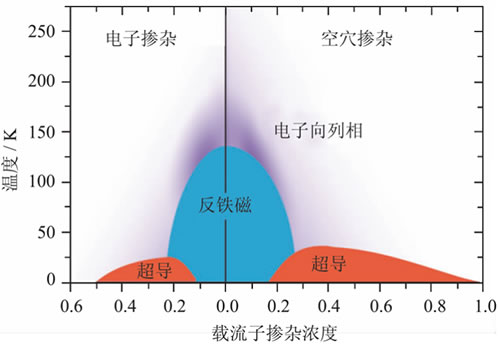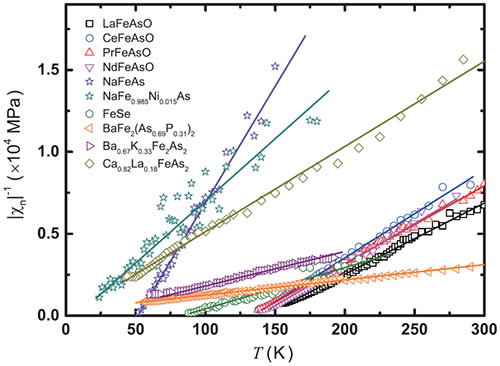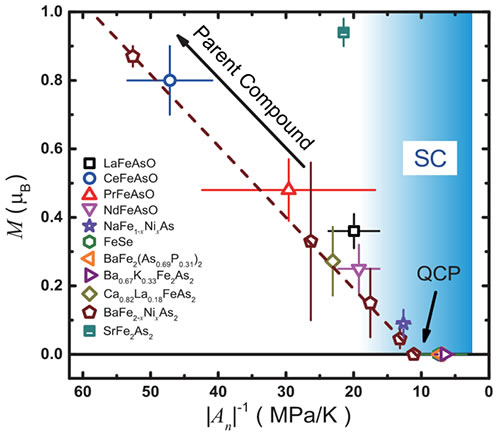Since its discovery in 2008, at least 20 different structures of iron arsenide or iron selenide have been demonstrated to have superconductivity. They are collectively referred to as iron-based superconductors. Since iron-based superconductors can also exceed the 40-kilometer McMillan limit predicted by the BCS strong coupling theory, it is included in the HTS family together with copper oxide superconductors, and its superconducting microscopic mechanism is still in the crown of the field of condensed-matter physics. Pearl.
After years of research, it is generally believed that the high temperature and superconductivity of copper oxide can all be regarded as the doping of the mother body of the antiferromagnetic Mote insulator, so there is a unified description of the phase diagram. For iron-based superconductors, the so-called "matrix" is anti-ferromagnetic, but exhibits metal conductivity (with a certain concentration of carriers), which can be induced by doping the parent with electrons, holes, or even valences. Out of superconductivity. What is even more difficult to understand is that a significant portion of the undoped iron-based superconducting "matrix" itself is even superconductive, and further doping may instead inhibit superconductivity. The iron-based superconductors of different systems have strange electronic phase diagrams. Using doping concentration as a variable alone is insufficient to accurately describe the physical behavior. Therefore, the search for uniform variables describing the physical properties of iron-based superconductors and the strict physical meaning of the matrix have become one of the focuses of iron-based superconducting mechanisms.
Recently, the SC8 research group of the Institute of Physics of the Chinese Academy of Sciences/Beijing National Laboratory for Condensed Matter Physics (CPC) conducted a series of nematic phase fluctuation properties for a large number of iron-based sample precursors and doped samples by measuring resistance behavior under uniaxial pressure. A detailed study found that antiferromagnetic ordered magnetic moments are inversely proportional to the nematic Curie constant. This implies that the magnetic ground state of the iron-based superconductor can be obtained by adjusting the intensity of the nematic fluctuation. A uniform phase diagram of iron-based superconductors can thus be established in which superconductors originate from a hypothetically ideal matrix, which has large ordered magnetic moments and weaker nematic fluctuations.
Careful observation of doped phase diagrams of iron-based superconductors in different systems reveals that antiferromagnetic ordering, superconductivity, and electron nematic phase are the most prominent features (Figure 1). The electron nematic phase refers to an electronic state that breaks the intrinsic rotational symmetry of the crystal lattice in the system and double-symmetrical electronic state in the crystal ab plane in the iron-based superconductor. Finding the specific relationship between antiferromagnetism, superconductivity and nematic phase is the key to understanding the microscopic mechanism of iron-based superconductivity. Although antiferromagnetic sequences do not exist in certain iron-based superconductors, electron nematic or nematic fluctuations always exist. Based on a set of independent uniaxial electro-mechanical pressure measuring devices based on piezoelectric ceramics, the research group achieved very precise measurements of electronic nematic fluctuations and revealed for the first time a nematic quantum critical point and iron-based Close contact with superconductivity. By more extensively measuring a series of samples of iron-based superconductors such as 1111, 122, 11, 111, and 112, they found that the nematic magnetic susceptibility of a sample with a second-order phase transition, or an optimally doped sample, The temperature-dependent behavior can be described by the Curie-Weiss law (Fig. 2). From this, a Curie constant An can be defined to describe the nematic phase fluctuation intensity. The inverse of the absolute value of the Curie constant |An|-1, and the static effective magnetic moment M of the iron-based superconductor, form a very simple linear scale relationship, that is, the stronger the nematic fluctuation, the more antiferromagnetism it has. weak. This is the first time in the experiment to associate the magnitude of the antiferromagnetic ordered magnetic moment with another physical quantity. When the antiferromagnetic and nematic phases disappear, a quantum critical point is formed, which corresponds to the optimum doping superconductivity (Figure 3). From this, it is possible to physically define a strictly iron-based superconducting mother (HPC), which has a large ordered magnetic moment and very weak nematic fluctuations. By enhancing the nematic fluctuations, it is possible to suppress its antiferromagnetism and finally obtain high-temperature superconductivity (Fig. 4). The establishment of this unified electronic phase diagram opens up a new perspective for understanding the complex doping physical behaviors in different iron-based superconducting systems, and has important implications for the study of the micro-mechanism of iron-based superconductors. It should be pointed out that this phase diagram may still not explain some special iron-based superconductor materials, such as LiFeAs, the second superconducting region in the “1111†system, the FeSe phase diagram under pressure, and Cu that is not superconducting. Cr, Mn doping system. This work was published in Physical Review Letters.
The series of research work has been awarded by the Chinese Academy of Sciences for strategic pilot projects (Class B), the Chinese Academy of Sciences Green Promotion Association, the National Key Basic Research and Development Program (973 Program), the National Key R&D Program, the National Natural Science Foundation, and the National Youth Talents Program. stand by.

Figure 1. Conventional doped phase diagram of iron-based superconductors

Figure 2. Curie-Weiss temperature-dependent behavior of susceptibility of nematic nematic phase in iron-based superconductors of different systems

Figure 3. The scaling relationship between the Curie constant of the nematic phase and the anti-ferromagnetism magnetic moment of different iron-based superconductors.

Figure 4. Uniform phase diagram of an iron-based superconductor constructed using the Curie constant of the nematic phase as a parameter
106Cm Pvc Wallpaper,Pvc White Home Decor Wallpaper,Wall Home Decoration,Bedroom Living Room Tv Sticker
JIANGSU ARTSTYLE DECORATION MATERIALS CO..LTD , https://www.artstyledecor.com